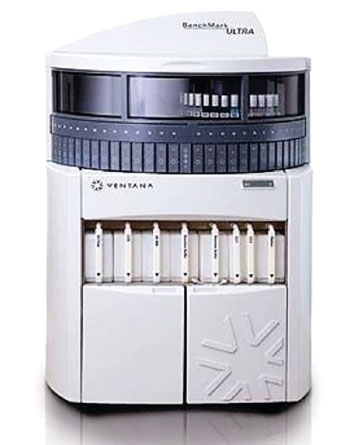Immunomarker Expression Clarified for Thoracic Tumors
By LabMedica International staff writers
Posted on 03 Jan 2016
Comprehensive morphological and immunohistochemical subtyping of tumors is of growing importance for therapy selection and propelled the concept of a tumor-specific, individualized treatment. Posted on 03 Jan 2016
Thoracic pathologists are frequently faced with tissue specimens from intrathoracic/mediastinal tumors and specifically the differentiation between thymic and pulmonary squamous cell carcinomas (SqCC) can be challenging. For non-small-cell lung cancer (NSCLC) the current classification therefore has been extended by the concept of immunophenotyping from biopsies to resection specimens.

Image: The Benchmark Ultra Staining Instrument (Photo courtesy of Ventana).
Scientists at Heidelberg University (Germany) identified a cohort of 1,465 patients for whom formalin-fixed paraffin-embedded specimens of NSCLC were available. Prior to tissue microarray (TMA) construction, a hematoxylin and eosin (H&E)-stained slide of each block was analyzed in order to select representative tumor-containing regions.
A TMA machine (AlphaMetrix Biotech; Rödermark, Germany) was used to extract a tandem 1.0 mm cylindrical core sample from each tissue donor block. Immunohistochemistry (IHC) was performed with commercially available antibodies and TMA slides were deparaffinized and pretreated with antigen retrieval buffer. Subsequent steps were performed on a BenchMark Ultra, immunostaining instrument (Ventana, Tucson, AZ, USA). The TMA resection specimens were stained with antibodies against CD117 and CD5.
CD117 was positive in 145 out of 1,457 evaluable cases (9.9%) and CD5 was positive in 133 out of 1,427 evaluable cases (9.3%). Coexpression of CD117 and CD5 was seen in 28 cases (1.9%). Among the 145 cases that were positive for CD117, 97 (66.8%) were adenocarcinomas (ADC), 34 (23.4%) were SqCC, 5 (3.4%) were adenosquamous carcinomas (ADSqCC), 8 (5.5%) were large cell carcinomas (LC), and one (0.6%) was a pleomorphic carcinoma (PC). In the CD5 positive group consisting of 133 cases, 123 (92.4%) were ADC, four (3.0%) were ADSqCC, three (2.2%) LC and three (2.2%) were PC. None of the 586 SqCC showed expression of CD5.
The authors concluded that a substantial subset of NSCLC exhibit positivity of CD117 and CD5. Since CD5 expression was not observed in pulmonary SqCC, but is expressed in the majority of thymic squamous cell carcinomas, the application of this immunomarker is a valuable tool in the differential diagnosis of thoracic neoplasms. The study was published on December 8, 2015, in the journal Diagnostic Pathology.
Related Links:
Heidelberg University
AlphaMetrix Biotech
Ventana














